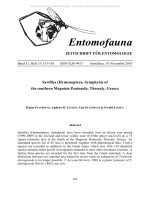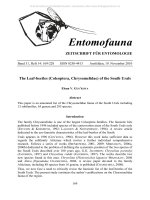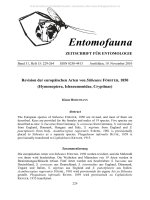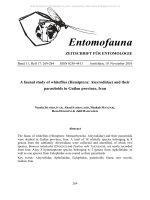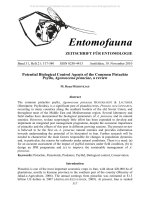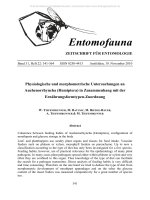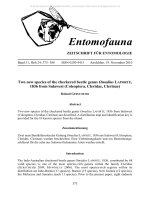Entomofauna, ZEITSCHRIFT FÜR ENTOMOLOGIE VOL 0031-0269-0284
Bạn đang xem bản rút gọn của tài liệu. Xem và tải ngay bản đầy đủ của tài liệu tại đây (475.06 KB, 16 trang )
© Entomofauna Ansfelden/Austria; download unter www.biologiezentrum.at
Entomofauna
ZEITSCHRIFT FÜR ENTOMOLOGIE
Band 31, Heft 17: 269-284
ISSN 0250-4413
Ansfelden, 19. November 2010
A faunal study of whiteflies (Hemiptera: Aleyrodidae) and their
parasitoids in Guilan province, Iran
Nasrin SHAHBAZVAR, Ahad SAHRAGARD, Shahab MANZARI,
Reza HOSSEINI & Jalil HAJIZADEH
Abstract
The fauna of whiteflies (Hemiptera: Sternorrhyncha: Aleyrodidae) and their parasitoids
were studied in Guilan province, Iran. A total of 18 whitefly species belonging to 8
genera from the subfamily Aleyrodinae were collected and identified, of which two
species, Bemisia takahashii (DANZIG) and Pealius rubi TAKAHASHI, are newly recorded
from Iran. Also, 8 hymenopteran species belonging to 2 genera from Aphelinidae, as
well as one species from Eulophidae were reared as their parasitoids.
Key words: Aleyrodidae, Aphelinidae, Eulophidae, parasitoids, fauna, new record,
Guilan, Iran.
269
© Entomofauna Ansfelden/Austria; download unter www.biologiezentrum.at
Introduction
Whiteflies are small insects (1-3 mm in body length) belonging to the order Hemiptera,
suborder Sternorrhyncha, superfamily Aleyrodoidea and family Aleyrodidae (MARTIN et
al. 2000). MARTIN & MOUND (2007) catalogued the whiteflies of the world and listed
1556 species in 161 genera from three subfamilies, Aleurodicinae, Aleyrodinae and
Udamoselinae. The subfamily Aleurodicinae is primarily distributed in New World and
includes 118 species in 18 genera; the subfamily Aleyrodinae is worldwide in
distribution and includes 1424 species in 148 genera, and the subfamily Udamoselinae
includes 2 South American species in a single genus Udamoselis (EVANS 2008). The
generic classification of the Aleyrodidae is based on the structure of the fourth larval
instar, the so-called pupal case, not on the structure of adults. This is of the great
advantage that the pupal cases are sessile, so it is possible to collect and identify host
plants with insects (MOUND & HALSEY 1978). Whiteflies cause damage to plants by
feeding on phloem sap. The importance of whiteflies as economic pests seems to expand
continually (BYRNE & BELLOWS 1991). Presently, three whitefly species, viz. Bemisia
tabaci (GENNADIUS), Trialeurodes vaporariorum (WESTWOOD), and T. abutiloneus
(HALDEMAN) are known to be vectors of plant viruses, of which B. tabaci is the most
important. This species associates with more than 100 viral diseases in the tropics and
subtropics (NAULT 1997). Hymenopteran parasitoids of whiteflies belong to six families:
Aphelinidae, Eulophidae, Pteromalidae, Signiphoridae and Encyrtidae from the
superfamily Chalcidoidea, and Platygastridae from the superfamily Platygastroidea.
These are known to be either facultative or obligate parasitoids of whiteflies
(HERNÁNDES-SUÁREZ et al. 2003)
The whitefly fauna of Iran has poorly been studied. There are a number of publications
on Iranian whiteflies in different regions (e.g. KIRIUKHIN 1947; ZARRABI 1991, 1998a,
1998b; ZARRABI & DAVID 2001; MANZARI 2005; MANZARI & ALEMANSOOR 2005;
MANZARI & MOGHADDAM 2005; SHAHBAZVAR et al. 2010). In the current study, 18
whitefly species including two new records, as well as 9 hymenopteran species as their
parasitoids are reported from Guilan province, Iran. The information on distribution and
host plants for each whitefly species is also provided.
Materials and methods
In order to study the fauna of whiteflies in Guilan province, the specimens were collected
from different localities during 2007-2009. Field-collected puparia were slide-mounted
and Canada balsam was employed as the permanent mounting medium. Also, reared
parasitoids for several of these whitefly species were collected and identified. Specimens
were deposited at Hayk Mirzayans Insect Museum (HMIM), Insect Taxonomy Research
Department, Iranian Research Institute of Plant Protection, P.O. Box 1454, Tehran
19395, Iran.
270
© Entomofauna Ansfelden/Austria; download unter www.biologiezentrum.at
Results
Aleurochiton acerinus HAUPT, 1934
M a t e r i a l e x a m i n e d : Iran, Guilan province: Talesh, Asalem, Nav-e Bala, 1580 m, N
= 37° 38′ 39″, E = 48° 39′ 39″, 27.x.2008, ex: Acer cappadocicum (Aceraceae), (N.
Shahbazvar, 223); Talesh, Asalem, 112 m, N = 37° 42′ 14″, E = 48° 56′ 27″, 27.x.2008, ex:
A. cappadocicum (Aceraceae), (N. Shahbazvar, 225).
D i s t r i b u t i o n : Austria, Czech Republic, England, Germany, Hungary, Iran,
Poland, USSR, Yugoslavia (EVANS 2008).
Aleurochiton pseudoplatani VISNYA, 1936
M a t e r i a l e x a m i n e d : Iran, Guilan province: Langarud, 4 m, N = 37° 11′ 16.6″, E =
50° 09′ 33.3″, 27.vi.2008, ex: Acer velutinum (Aceraceae), (N. Shahbazvar, 100); Rasht,
Khomam, Kateh Sar, -3 m, N = 37° 22′ 5.3″, E = 49° 41′ 25.6″, 27.viii.2008, ex: A.
velutinum (Aceraceae), (N. Shahbazvar, 127); Rasht, Kuchesfahan, Kenarsar Bozorg, 66 m,
N = 37° 20′ 4.8″, E = 49° 49′ 32.4″, 27.viii.2008, ex: A. velutinum (Aceraceae), (N.
Shahbazvar, 132); Shaft, Emamzadeh-Ebrahim, 125 m, N = 37° 03′ 22.7″, E = 49° 24′
40.3″, 28.viii.2008, ex: A. velutinum (Aceraceae), (N. Shahbazvar, 137); Fuman, Ghaleh
Roudkhan, 346 m, N = 37° 04′ 17.8″, E = 49° 14′ 53.8″, 30.viii.2008, ex: A. velutinum
(Aceraceae), (N. Shahbazvar, 144); Fuman, Gasht-e-Roudkhan, 705 m, N = 37° 03′ 49.1″,
E = 49° 14′ 19″, 03.ix.2008, ex: A. velutinum (Aceraceae), (N. Shahbazvar, 151); Fuman,
Gasht-e-Roudkhan, 110 m, N = 37° 07′ 04″, E = 49° 13′ 22″, 03.ix.2008, ex: A. velutinum
(Aceraceae), (N. Shahbazvar, 163); Rasht, Pir Bazar, -12 m, N = 37° 20′ 24″, E = 49° 31′
14″, 17.x.2008, ex: A. velutinum (Aceraceae), (N. Shahbazvar, 175); Bandar-e Anzali, -15
m, N = 37° 28′ 16″, E = 49° 27′ 42″, 20.x.2008, ex: A. velutinum (Aceraceae), (N.
Shahbazvar, 187); Rasht, Lakan, 14 m, N = 37° 11′ 35″, E = 49° 34′ 42″, 24.x.2008. ex: A.
velutinum (Aceraceae), (N. Shahbazvar, 209); Talesh, Haviq, 1 m, N = 38° 09′ 29″, E = 48°
52′ 43″, 25.x.2008, ex: A. velutinum (Aceraceae); Talesh, Lisar, 24 m, N = 37° 58′ 6.5″, E =
48° 53′ 54″, 25.x.2008, ex: A. velutinum (Aceraceae), (N. Shahbazvar, 217); Talesh,
Asalem, Nav Rud, -2 m, N = 37° 43′ 21″, E = 49° 02′ 10″, 27.x.2008, ex: A. velutinum
(Aceraceae), (N. Shahbazvar, 226); Astara, Gila Deh, 679 m, N = 38° 23′ 13″, E = 48° 38′
55″, 1.xi.2008, ex: A. velutinum (Aceraceae), (N. Shahbazvar, 235); Rudsar, Kalachay, -10
m, N = 37° 04′ 44″, E = 50° 23′ 43″, 13.xi.2008, ex: A. velutinum (Aceraceae), (N.
Shahbazvar, 244); Rasht, Lakan, 14 m, N = 37° 11′ 35″, E = 49° 34′ 42″, 16.xi.2008, ex: A.
velutinum (Aceraceae), (N. Shahbazvar, 249); Rasht, Sangar, 96 m, N = 37° 10′ 42″, E =
49° 41′ 38″, 25.vi.2009, ex: Acer sp. (Aceraceae(, (N. Shahbazvar, 252).
D i s t r i b u t i o n : Austria, Czech Republic, Germany, Hungary, Iran, Lebanon,
Netherlands, USSR (EVANS 2008).
271
© Entomofauna Ansfelden/Austria; download unter www.biologiezentrum.at
Parasitoid collected:
Encarsia sophia (GIRAULT & DODD, 1915)
M a t e r i a l e x a m i n e d : Iran, Guilan province: Talesh, Asalem, Nav Rud, -2 m, N = 37°
43′ 21″, E = 49° 02′ 10″, 27.x.2008, ex: Aleurochiton pseudoplatanoi on Acer velutinum
(Aceraceae), (N. Shahbazvar, 226).
Encarsia protransvena VIGGIANI, 1985
M a t e r i a l e x a m i n e d : Iran, Guilan province: Fuman, Gasht-e-Roudkhan, 110 m, N =
37° 07′ 04″, E = 49° 13′ 22″, 03.ix.2008, ex: Aleurochiton pseudoplatani on Acer velutinum
(Aceraceae), (N. Shahbazvar, 163); Rasht, Pir Bazar, -12 m, N = 37° 20′ 24″, E = 49° 31′
14″, 17.x.2008. ex: Aleurochiton pseudoplatani on Acer velutinum (Aceraceae), (N.
Shahbazvar, 175).
Aleuroclava kharazii MANZARI & SHAHBAZVAR, 2010
This species has recently been described from Iran by SHAHBAZVAR et al. (2010).
M a t e r i a l e x a m i n e d : Holotype, Iran, Guilan province: Astara, -27 m, N = 37° 24' 44",
E = 48° 52' 34", 1.xi.2008, ex: Nerium oleander (Apocynaceae), (N. Shahbazvar, 232);
Paratype, Talesh, Asalem, 131 m, N = 37° 09' 83", E = 48° 32' 88", 3.xi.2008, ex:
Crataegus monogyna (Rosaceae), (N. Shahbazvar, 219).
D i s t r i b u t i o n : Iran (SHAHBAZVAR et al., 2010).
Aleyrodes sp. cf. elevatus SILVESTRI, 1934
M a t e r i a l e x a m i n e d : Iran, Guilan province: Astanehye-Ashrafiyeh, Kiyashahr, Ziba
Kenar, 11 m, N = 37° 25′ 60″, E = 49° 14′ 18″, 27.xiii.2008, ex: Lythrum salicaria
(Lythraceae), (N. Shahbazvar, 128); Fuman, Ghaleh Roudkhan, 430 m, N = 37° 04′ 5.5″, E
= 49° 14′ 39.2″, 30.xiii.2008, ex: Rosaceae, (N. Shahbazvar, 150).
Parasitoid collected:
Encarsia inaron (WALKER, 1839)
M a t e r i a l e x a m i n e d : Iran, Guilan province: Fuman, Ghaleh Roudkhan, 430 m, N =
37° 04′ 5.5″, E = 49° 14′ 39.2″, 30.xiii.2008, ex: Aleyrodes sp. cf. elevatus on Rosaceae, (N.
Shahbazvar, 150).
272
© Entomofauna Ansfelden/Austria; download unter www.biologiezentrum.at
Aleyrodes lonicerae WALKER, 1852
M a t e r i a l e x a m i n e d : Iran, Guilan province: Rasht, Emamzadeh-Hashem, Kocha, 116
m, N = 37° 05′ 29.7″, E = 49° 37′ 42.5″, 22.xiii.2008, ex: Violaceae, (N. Shahbazvar, 117);
Rasht, Emamzadeh-Hashem, Siah Roud, Harkian, 87 m, N = 37° 05′ 27.3″, E = 49° 37′
42.5″, 22.xiii.2008, ex: Rubus sp. (Rosaceae), (N. Shahbazvar, 118); Astanehye-Ashrafiyeh,
Kiyashahr, 11 m, N = 37° 25′ 15″, E = 49° 56′ 56″, 27.xiii.2008, ex: Rubus sp. (Rosaceae),
(N. Shahbazvar, 133); Shaft, 35 m, N = 37° 12′ 31.3″, E = 49° 26′ 7.4″, 28.xiii.2008, ex:
Cucumis sativa (Cucurbitaceae), (N. Shahbazvar, 142); Fuman, Ghaleh Roudkhan, 705 m,
N = 37° 03′ 49.1″, E = 49° 14′ 19″, 30.xiii.2008, ex: Rosaceae, (N. Shahbazvar, 147);
Fuman, Ghaleh Roudkhan, 430 m, N = 37° 04′ 5.5″, E = 49° 14′ 39.2″, 30.xiii.2008, ex:
Viola sp. (Violaceae), (N. Shahbazvar, 149); Fuman, Ghaleh Roudkhan, 705 m, N = 37° 03′
49.1″, E = 49° 14′ 19″, 30.xiii.2008, ex: unknown, (N. Shahbazvar, 155), Rudsar, Rahim
Abad, Ziyaz, 681 m, N = 36° 52′ 0.0″, E = 50° 13′ 0.0″, 19.x.2008, ex: unknown, (N.
Shahbazvar, 182); Rasht, Sarawan, 97 m, N = 37° 01′ 49″, E = 49° 37′ 49″, 24.x.2008, ex:
Geum sp. (Rosaceae), (N. Shahbazvar, 207); Talesh, Haviq, 1 m, N = 38° 09′ 29″, E = 48°
52′ 43″, 25.x.2008, ex: Viola alba (Violaceae), (N. Shahbazvar, 218); Talesh, Asalem, 670
m, N = 37° 40′ 99″, E = 48° 48′ 45″, 27.x.2008, ex: Lonicera sp. (Caprifoliaceae), (N.
Shahbazvar, 227); Talesh, Asalem, Nav Rud, 549 m, N = 37° 40′ 72.3″, E = 48° 47′ 97.7″,
7.xi.2008, ex: Lonicera sp. (Caprifoliaceae), (N. Shahbazvar, 229).
D i s t r i b u t i o n : Austria, England, Finland, France, Germany, Hungary, Iran,
Israel, Italy, Poland, Portugal, Russia, Sweden, Switzerland, Turkey, USSR, Yugoslavia,
Korea (EVANS 2008).
Parasitoid collected:
Encarsia inaron (WALKER, 1839)
M a t e r i a l e x a m i n e d : Iran, Guilan province: Fuman, Ghaleh Roudkhan, 430 m, N =
37° 04′ 5.5″, E = 49° 14′ 39.2″, 30.xiii.2008, ex: Aleyrodes lonicerae on Viola sp.
(Violaceae), (N. Shahbazvar, 149); Fuman, Ghaleh Roudkhan, 705 m, N = 37° 03′ 49.1″, E
= 49° 14′ 19″, 30.xiii.2008, ex: Aleyrodes lonicerae on unknown host plant, (N.
Shahbazvar, 155).
Euderomphale chelidonii ERDÖS, 1966
M a t e r i a l e x a m i n e d : Iran, Guilan province: Rasht, Emamzadeh-Hashem, Kocha, 116
m, N = 37° 05′ 29.7″, E = 49° 37′ 42.5″, 22.xiii.2008, ex: Aleyrodes lonicerae on Violaceae,
(N. Shahbazvar, 117); Rasht, Sarawan, 97 m, N = 37° 01′ 49″, E = 49° 37′ 49″, 24.x.2008,
ex: Aleyrodes lonicerae on Geum sp. (Rosaceae), (N. Shahbazvar, 207).
273
© Entomofauna Ansfelden/Austria; download unter www.biologiezentrum.at
Aleyrodes proletella (LINNAEUS, 1758)
M a t e r i a l e x a m i n e d : Iran, Guilan province: Shaft, 649 m, N = 37° 01′ 10″, E = 49°
26′ 19″, 28.xiii.2008, ex: Chelidonium majus (Papaveraceae), (N. Shahbazvar, 229);
Fuman, Ghaleh Roudkhan, 705 m, N = 37° 03′ 49.1″, E = 49° 14′ 19″, 30.viii.2008, ex:
Atropa belladonna (Solanaceae), (N. Shahbazvar, 145); Talesh, Asalem, Nav Rud, 549 m,
N = 37° 40′ 72.3″, E = 48° 47′ 97.7″, 7.xi.2008, ex: Lonicera sp. (Caprifoliaceae), (N.
Shahbazvar, 229).
D i s t r i b u t i o n : Worldwide (EVANS 2008).
Aleyrodes sp. cf. zygia DANZIG, 1966
M a t e r i a l e x a m i n e d : Iran, Guilan province: Fuman, Ghaleh Roudkhan, 705 m, N =
37° 03′ 49.1″, E = 49° 14′ 19″, 30.xiii.2008, ex: Euphorbia sp. (Euphorbiaceae), (N.
Shahbazvar, 148); Shaft, Emamzadeh-Eshagh, 626 m, N = 37° 02′ 60″, E = 49° 19′ 22″,
2.ix.2008, ex: Euphorbia sp. (Euphorbiaceae), (N. Shahbazvar, 155').
Parasitoid collected:
Encarsia inaron (WALKER, 1839)
M a t e r i a l e x a m i n e d : Iran, Guilan province: Shaft, Emamzadeh-Eshagh, 626 m, N =
37° 02′ 60″, E = 49° 19′ 22″, 2.ix.2008, ex: Aleyrodes sp. cf. zygia on Euphorbia sp.
(Euphorbiaceae), (N. Shahbazvar, 155′).
Bemisia afer (PRIESNER & HOSNY, 1934) s.l.
M a t e r i a l e x a m i n e d : Iran, Guilan province: Rasht, 48 m, 75m, N = 37° 11′ 45.1″, E =
49° 38′ 26.1″, 20.x.2008, ex: Morus alba (Moraceae), (N. Shahbazvar, 107); Rasht,
Sarawan, 75m, N = 37° 02′ 28″, E = 49° 38′ 15″, 24.x.2008, ex: Rubus sp. (Rosaceae), (N.
Shahbazvar, 117); Shaft, Emamzadeh-Ebrahim, 649 m, N = 37° 01′ 10″, E = 49° 26′ 19″,
28.xiii.2008, ex: Chelidonium majus (Papaveraceae), (N. Shahbazvar, 144).
D i s t r i b u t i o n : Brazil, Egypt, France, Iran, Israel, Italy, Sicily, Spain, Cameroon,
Chad, Congo, Guinea, Ivory Coast, Kenya, Madagascar, Mulawi, Niger, Nigeria, Sierre
Leon, South Africa, Sudan, Uganda, Zaire, China, Korea, India, Pakistan, Australia, New
Guinea (EVANS 2008).
Bemisia sp. cf. carpini (KOCH, 1857)
M a t e r i a l e x a m i n e d : Iran, Guilan province: Talesh, Asalem, 112 m, N = 37° 42′ 14″,
E = 48° 56′ 27″, 27.x.2008, ex: Ulmus sp. (Ulmaceae), (N. Shahbazvar, 224).
Bemisia dentata (DANZIG, 1969)
M a t e r i a l e x a m i n e d : Iran, Guilan province: Astara, Gila Deh, 679 m, N = 38° 23′
13″, E = 48° 38′ 55″, 1.xi.2008, ex: Rosa sp. (Rosaceae), (N. Shahbazvar, 234).
274
© Entomofauna Ansfelden/Austria; download unter www.biologiezentrum.at
D i s t r i b u t i o n : France, Iran, Netherlands, USSR (EVANS 2008).
Bemisia shinanoensis KUWANA, 1922
M a t e r i a l e x a m i n e d : Iran, Guilan province: Rasht, Sarawan, 7 m, N = 37° 02′ 28″, E
= 49° 38′ 15″, 22.xiii.2008, ex: Parrotia persica (Hammamelidaceae), (N. Shahbazvar,
116); Rasht, 4 m, N = 37° 16′ 46″, E = 49° 35′ 09″, 2.xi.2008, ex: Morus alba (Muraceae),
(N. Shahbazvar, 240); Shaft, Ahmad Sargurab, Alisara, 325 m, N = 37° 03′ 24″, E = 49° 17′
38″, 2.xi.2008, ex: Pterocarya fraxinifolia (Juglandaceae), (N. Shahbazvar, 242); Rudsar,
Siyahkal, 34 m, N = 37° 09′ 13″, E = 49° 52′ 11″, 13.x.2008, ex: M. alba (Moraceae), (N.
Shahbazvar, 247).
D i s t r i b u t i o n : Iran, Japan (EVANS 2008).
Bemisia tabaci (GENNADIUS, 1889)
M a t e r i a l e x a m i n e d : Iran, Guilan province: Rudsar, Chaboksar, Sarwlat, 19 m, N =
36° 56′ 59.6″, E = 50° 32′ 52.5″, 20.xiii.2008, ex: unknown, (N. Shahbazvar, 113); Rudsar,
Chaboksar, Sarwlat, 19 m, N = 36° 56′ 59.6″, E = 50° 32′ 52.5″, 20.xiii.2008, ex: Cucurbita
maxima (Cucurbitaceae), (N. Shahbazvar, 114); Rasht, Emamzadeh-Hashem, Siah Roud,
Harkian, 87 m, N = 37° 05′ 27.3″, E = 49° 37′ 42.3″, 22.xiii.2008, ex: Rubus sp.
(Rosaceae), (N. Shahbazvar, 118); Astanehye-Ashrafiyeh, Kiyashahr, Ziba Kenar, 11 m, N
= 37° 25′ 60″, E = 49° 52′ 22″, 27.xiii.2008, ex: Lythrum salicaria (Lythraceae), (N.
Shahbazvar, 128); Rasht, Kuchesfahan, Kenarsar Bozorg, 66 m, N = 37° 20′ 4.8″, E = 49°
49′ 32.4″, 27.xiii.2008, ex: Abutilon teophrasti (Malvaceae), (N. Shahbazvar, 129); Rasht,
Kuchesfahan, Kenarsar Bozorg, 66 m, N = 37° 20′ 4.8″, E = 49° 49′ 32.4″, 27.xiii.2008, ex:
Rubus sp. (Rosaceae), (N. Shahbazvar, 130); Astanehye-Ashrafiyeh, Kiyashahr, 11 m, N =
37° 25′ 15″, E = 49° 56′ 56″,27.xiii.2008, ex: Rubus sp. (Rosaceae), (N. Shahbazvar, 133);
Shaft, Choobar, 377 m, N = 37° 16′ 30″, E = 49° 23′ 18″, 28.xiii.2008, ex: Euphorbia sp.
(Euphorbiaceae), (N. Shahbazvar, 141); Rezvanshahr, Parreh Sar, Gisoom, 13 m, N = 37°
39′ 03″, E = 49° 01′ 35″, 3.ix.2008, ex: Euphorbia sp. (Euphorbiaceae), (N. Shahbazvar,
157); Bandar-e Anzali, Chapar Khaneh, -10 m, N = 37° 25′ 47″, E = 49° 38′ 45″, 18.x.2008,
ex: C. maxima (Cucurbitaceae), (N. Shahbazvar, 177); Rudsar, Rahim Abad, Ziyaz, 681 m,
N = 36° 52′ 0.0″, E = 50° 13′ 0.0″, 19.x.2008, ex: Lamium album (Lamiaceae), (N.
Shahbazvar, 184); Rasht, Pir Bazar, -12m, N = 37° 20′ 24″, E = 49° 31′ 14″, 20.x.2008, ex:
Rubus sp. (Rosaceae), (N. Shahbazvar, 194); Rezvanshahr, Ziyabar, 0 m, N = 37° 24′ 32″,
E = 49° 14′ 18″, 23.x.2008, ex: Rubus sp. (Rosaceae), (N. Shahbazvar, 198); Sowmaeh
Sara, Chomesghal, -9 m, N = 37° 21′ 59″, E = 49° 21′ 44″, 23.x.2008, ex: Rubus sp.
(Rosaceae), (N. Shahbazvar, 203); Rasht, Lakan, Salkisar, 42m, N = 37° 10′ 35″, E = 49°
34′ 22″, 24.x.2008, ex: Rubus sp. (Rosaceae), (N. Shahbazvar, 210); Shaft, Ahmad
Sargurab, Siyah Mazgi, 600 m, N = 37° 01′ 03″, E = 49° 16′ 12″, 2.xi.2008, ex:
Clerodendron bungei (Verbenaceae), (N. Shahbazvar, 234).
D i s t r i b u t i o n : Worldwide (EVANS 2008).
275
© Entomofauna Ansfelden/Austria; download unter www.biologiezentrum.at
Parasitoid collected:
Encarsia pergandiella HOWARD, 1907
M a t e r i a l e x a m i n e d : Iran, Guilan province: Rasht, Kuchesfahan, Kenarsar Bozorg,
66 m, N = 37° 20′ 4.8″, E = 49° 49′ 32.4″, 27.xiii.2008, ex: Bemisia tabaci on Abutilon
teophrasti (Malvaceae), (N. Shahbazvar, 129).
Eretmocerus mundus MERCET, 1931
M a t e r i a l e x a m i n e d : Iran, Guilan province: Guilan: Rasht, Kuchesfahan, Kenarsar
Bozorg, 66 m, N = 37° 20′ 4.8″, E = 49° 49′ 32.4″, 27.xiii.2008, ex: Bemisia tabaci on
Rubus sp. (Rosaceae), (N. Shahbazvar, 130).
Bemisia takahashii (DANZIG, 1966)
This species is newly recorded from Iran.
M a t e r i a l e x a m i n e d : Iran, Guilan province: Rasht, Lakan, Eskadeh, 131 m, N = 37°
09′ 83″, E = 49° 32′ 88″, 26.x.2008, ex: Crataegus monogyna (Rosaceae), (N. Shahbazvar,
219); Astara, Heyran, 785 m, N = 38° 22′ 19″, E = 48° 38′ 53″, 1.xi.2008, ex: Crataegus sp.
(Rosaceae), (N. Shahbazvar, 233); Rudsar, -3 m, N = 36° 58′ 0.0″, E = 49° 43′ 0.0″,
13.xi.2008, ex: Crataegus sp. (Rosaceae), (N. Shahbazvar, 248).
D i s t r i b u t i o n : Maritime Territory (USSR), Korea (EVANS 2008).
Bulgarialeurodes cotesii (MASKELL, 1896)
M a t e r i a l e x a m i n e d : Iran, Guilan province: Astara, Heyran, 785 m, N = 38° 22′ 19″,
E = 48° 38′ 53″, 1.xi.2008, ex: Rosa lutea (Rosaceae), (N. Shahbazvar, 236); Talesh, Lisar,
Khotbe Sara, 6m, N = 37° 59′ 73.5″, E = 48° 54′ 20.4″, 1.xi.2008, ex: R. lutea (Rosaceae),
(N. Shahbazvar, 237).
D i s t r i b u t i o n : Afganistan, Bulgaria, Iran, Rumania, Turkmenistan, USSR,
Yugoslavia, Pakistan (EVANS 2008).
276
© Entomofauna Ansfelden/Austria; download unter www.biologiezentrum.at
Dialeurodes citri (ASHMEAD, 1885)
M a t e r i a l e x a m i n e d : Iran, Guilan province: Lahidjan, 1 m, N = 37° 12′ 33″, E = 50°
0′ 02″, 27.vi.2008, ex: Citrus auvantium (Rutaceae), (N. Shahbazvar, 102); Langarud, 4 m,
N = 37° 11′ 16.6″, E = 50° 09′ 33.3″, 27.vi.2008, ex: C. auvantium (Rutaceae), (N.
Shahbazvar, 103); Rasht, Sangar, 42 m, N = 37° 11′ 44.9″, E = 49° 38′ 26″, 27.vi.2008, ex:
Euonymus japonicus (Euphorbiaceae), (N. Shahbazvar, 104); Lahidjan, 50 m, N = 37° 11′
41.1″ , E = 50° 01′ 0.8″, 18.viii.2008, ex: Citrus sinensis (Rutaceae), (N. Shahbazvar, 106);
Lahidjan, Chayjan, -3 m, N = 37° 01′ 49″, E = 50° 27′ 20″, 18.viii.2008, ex: C. auvantium
(Rutaceae), (N. Shahbazvar, 107); Rasht, 48 m, N = 37° 11′ 45.1″, E = 49° 38′ 26.1″,
16.viii.2008, ex: C. auvantium (Rutaceae), (N. Shahbazvar, 108); Langarud, Kumeleh, 14
m, N = 37° 08′ 39″, E = 50° 10′ 26.8″, 20.viii.2008, ex: C. sinensis (Rutaceae), (N.
Shahbazvar, 109); Langarud, Amlash, 13 m, N = 37° 05′ 51″, E = 50° 11′ 01″, 20.viii.2008,
ex: Ligustrum vulgar (Oleaceae), (N. Shahbazvar, 110); Langarud, Amlash, 13 m, N = 37°
05′ 51″, E = 50° 11′ 01″, 20.viii.2008, ex: C. sinensis (Rutaceae), (N. Shahbazvar, 111);
Rudsar, Kalachay, Vajargah, Siahkalroud, 63 m, N = 37° 01′ 15.5″, E = 50° 26′ 23.9″,
20.viii.2008, ex: C. sinensis (Rutaceae), (N. Shahbazvar, 115); Rasht, Kuchesfahan, 48 m,
N = 37° 11′ 45.1″, E = 49° 38′ 26.1″, 27.viii.2008, ex: C. sinensis (Rutaceae), (N.
Shahbazvar, 126); Shaft, Choobar, 377 m, N = 37° 16′ 30″, E = 49° 23′ 18″, 28.viii.2008,
ex: C. sinensis (Rutaceae), (N. Shahbazvar, 143); Fuman, Gasht, 86 m, N = 37° 10′ 15″ , E
= 49° 15′ 55″, 3.ix.2008, ex: C. auvantium (Rutaceae), (N. Shahbazvar, 159); Fuman,
Gasht-e-Roudkhan, 110 m, N = 37° 07′ 04″ , E = 49° 13′ 22″, 3.ix.2008, ex: Ligustrum
vulgar (Oleaceae), (N. Shahbazvar, 161); Fuman, Gasht-e-Roudkhan, 110 m, N = 37° 07′
04″, E = 49° 13′ 22″, 3.ix.2008, ex: Lonicera sp. (Caprifoliaceae), (N. Shahbazvar, 162);
Fuman, Gasht-e-Roudkhan, 3 m, N = 37° 17′ 45″, E = 49° 13′ 18″, 12.x.2008, ex: C.
auvantium (Rutaceae), (N. Shahbazvar, 188); Rezvanshahr, 15 m, N = 37° 32′ 53″, E = 49°
07′ 26″, 23.x.2008, ex: Punica granatum (Punicaceae), (N. Shahbazvar, 199); Rezvanshahr,
15 m, N = 37° 32′ 53″, E = 49° 07′ 26″, 23.x.2008, ex: C. medica (Rutaceae), (N.
Shahbazvar, 200); Hashtpar, Kish Dibi, -12 m, N = 37° 50′ 21″ , E = 48° 48′ 57″,
25.x.2008, ex: Ligustrum sinense (Oleaceae), (N. Shahbazvar, 216); Astara, -27 m, N = 38°
24′ 44″, E = 48° 52′ 34″, 1.xi.2008, ex: Evonymus japonica (Celasteraceae), (N.
Shahbazvar, 231); Rudsar, -3 m, N = 36° 58′ 0″, E = 49° 43′ 0″, 13.xi.2008, ex: C.
auvantium (Rutaceae), (N. Shahbazvar, 246); Rudsar, Deylaman, Lunak water fall, 619 m,
N = 37° 02′ 14″, E = 49° 53′ 23″, 27.vi.2009, ex: C. Sinensis (Rutaceae), (N. Shahbazvar,
253).
D i s t r i b u t i o n : USA, Bahamas, Bermuda, Cuba, Dominican Republic, El
Salvador, Haiti, Honduras, Mexico, Panama, Puerto Rico, Afganistan, France, Greece,
Iran, Italy, Portugal, Sicily, Turkey, China, Hong Kong, Korea, Japan, Macau, Taiwan,
India, Pakistan, Philippines, Thailand, Guam, Hawaii (EVANS 2008).
Pealius rubi TAKAHASHI, 1936
This species is newly recorded from Iran.
M a t e r i a l e x a m i n e d : Iran, Guilan province: Rasht, Sarawan, 75 m, N = 37° 02’ 28″,
E = 49° 38’ 15″, 24.x.2008, ex: Rubus sp. (Rosaceae), (N. Shahbazvar, 206); Talesh,
Asalem, Nav-e Bala, 1540 m, N = 37° 38’ 39″, E = 48° 38’ 39″, 27.x.2008, ex: Rosa canina
(Rosaceae), (N. Shahbazvar, 228); Talesh, Asalem, Nav-e Bala, 549 m, N = 37° 40’ 72.3″,
E = 48° 47’ 97.7″, 7.xi.2008, ex: Lonicera sp. (Caprifoliaceae), (N. Shahbazvar, 229).
D i s t r i b u t i o n : Japan, Korea, Taiwan (EVANS 2008).
277
© Entomofauna Ansfelden/Austria; download unter www.biologiezentrum.at
Trialeurodes packardi (MORRILL, 1903)
M a t e r i a l e x a m i n e d : Iran, Guilan province: Rasht, Pir Bazar, -12 m, N = 37° 20′ 24″,
E = 49° 31′ 14″, 20.x.2008, ex: Fragaria vesca (Rosaceae), (N. Shahbazvar, 192);
Hashtpar, Kish Dibi, -12 m, N = 37° 50′ 21″, E = 48° 48′ 57″, 25.x.2008, ex: Acer sp.
(Aceraceae), (N. Shahbazvar, 215).
D i s t r i b u t i o n : Canada, USA, Hungary, Iran, Korea (EVANS 2008).
Trialeurodes vaporariorum (WESTWOOD, 1856)
M a t e r i a l e x a m i n e d : Iran, Guilan province: Lahidjan, 1 m, N = 37° 12′ 33″, E = 50°
0′ 02″, 27.vi.2008, ex: Conyza canadensis (Asteraceae), (N. Shahbazvar, 101); Rasht,
Sangar, 42 m, N = 37° 11′ 44.9″, E = 49° 38′ 26″, 27.vi.2008, ex: Cucurbita maxima
(Cucurbitaceae), (N. Shahbazvar, 105); Langarud, Kumeleh, 14 m, N = 37° 8′ 39″, E = 50°
10′ 26.8″, 20.viii.2008, ex: Citrus sinensis (Rutaceae), (N.Shahbazvar, 112); Rudsar,
Chaboksar, Sarwlat, 19 m, N = 36° 56′ 59.6″, E = 50° 32′ 52.5″, 20.viii.2008, ex: C.
maxima (Cucurbitaceae), (N. Shahbazvar, 114); Rudbar, Rostam Abad, Tutkabon, 360 m, N
= 36° 43′ 44.8″ , E = 49° 24′ 32.8″, 22.viii.2008, ex: Cucurbita sativa (Cucurbitaceae), (N.
Shahbazvar, 119); Rudbar, Loyeh, 250 m, N = 36° 50′ 7.2″, E = 49° 26′ 0.9″, 22.viii.2008,
ex: Abutilon teophrasti (Malvaceae), (N. Shahbazvar,120); Rasht, Emamzadeh-Hashem,
360 m, N = 37° 0′ 39″, E = 49° 34′ 55″, 24.viii.2008, ex: A. teophrasti (Malvaceae), (N.
Shahbazvar, 121); Rasht, Emamzadeh-Hashem, 160 m, N = 37° 0′ 39″ , E = 49° 34′ 55″,
24.viii.2008, ex: C. sativa (Cucurbitaceae), (N. Shahbazvar, 122); Rasht, EmamzadehHashem, Diz Koh, 163 m, N = 37° 0′ 36″, E = 49° 34′ 29″, 24.viii.2008, ex: Trichosanthes
anguina (Cucurbitaceae), (N. Shahbazvar, 123); Rasht, Emamzadeh-Hashem, Diz Koh, 163
m, N = 37° 0′ 36″, E = 49° 34′ 29″, 24.viii.2008, ex: A. teophrasti (Malvaceae), (N.
Shahbazvar, 124); Rasht, Kuchesfahan, 125 m, N = 37° 11′ 45.1″, E = 49° 38′ 26.1″,
27.viii.2008, ex: A. teophrasti (Malvaceae), (N. Shahbazvar, 125); Rasht, Kuchesfahan, 66
m, N = 37° 11′ 45.1″, E = 49° 38′ 26.1″, 27.viii.2008, ex: C. maxima (Cucurbitaceae), (N.
Shahbazvar, 131); Rasht, 48 m, N = 37° 11′ 45.1″, E = 49° 38′ 26.1″, 27.viii.2008, ex:
Erodium ciconium (Geraniaceae), (N. Shahbazvar, 133′); Rasht, Khoshkebijar, -7 m, N =
37° 22′ 41″, E = 49° 45′ 29″, 26.viii.2008, ex: C. sativa (Cucurbitaceae), (N. Shahbazvar,
134); Rasht, Shaft, Molla Sara, 49 m, N = 37° 09′ 53.8″, E = 49° 23′ 56.2″, 28.viii.2008, ex:
Phaseolus vulgaris (Fabaceae), (N. Shahbazvar, 140); Fuman, Gasht, 86 m, N = 37° 10′
15″, E = 49° 15′ 55″, 3.ix.2008, ex: (Boraginaceae), (N. Shahbazvar, 158); Fuman, Gasht,
86 m, N = 37° 10′ 15″, E = 49° 15′ 55″, 3.ix.2008, ex: A. teophrasti (Malvaceae), (N.
Shahbazvar, 160); Shaft, Ahmad Sargurab, 141 m, N = 37° 7′ 36″, E = 49° 21′ 54″,
3.ix.2008, ex: Helianthus annus (Asteraceae), (N. Shahbazvar, 164); Fuman, Masuleh, Bala
Makelvan, 268 m, N = 37° 10′ 60″, E = 49° 12′ 58″, 4.ix.2008, ex: Cucurbita citrullus
(Cucurbitaceae), (N. Shahbazvar, 165); Fuman, Masuleh, 989 m, N = 37° 09′ 35″ , E = 48°
59′ 33″, 4.ix.2008, ex: C. citrullus (Cucurbitaceae), (N. Shahbazvar, 166); AstanehyeAshrafiyeh, -7 m, N = 37° 15′ 54″, E = 49° 56′ 40″, 16.x.2008, ex: A. teophrasti
(Malvaceae), (N. Shahbazvar, 170); Astanehye-Ashrafiyeh, -7 m, N = 37° 15′ 54″, E = 49°
56′ 40″, 16.x.2008, ex: Phaseolus vulgaris (Fabaceae), (N. Shahbazvar, 171); AstanehyeAshrafiyeh, -7 m, N = 37° 15′ 54″, E = 49° 56′ 40″, 16.x.2008, ex: Rubenia pseudoacacia
(Fabaceae), (N. Shahbazvar, 172); Astanehye-Ashrafiyeh, -7 m, N = 37° 15′ 54″, E = 49°
56′ 40″, 16.x.2008, ex: Solanum melongena (Solanaceae), (N. Shahbazvar, 173); Rasht, Pir
Bazar, -12 m, N = 37° 20′ 24″, E = 49° 31′ 14″, 17.x.2008, ex: Helianthus tuberosus
(Asteraceae), (N. Shahbazvar, 176); Bandar-e Anzali, Chapar Khaneh, -10 m, N = 37° 25′
47″, E = 49° 38′ 45″, 18.x.2008, ex: C. maxima (Cucurbitaceae), (N. Shahbazvar, 177);
278
© Entomofauna Ansfelden/Austria; download unter www.biologiezentrum.at
Bandar-e Anzali, Sangachin, -27 m, N = 37° 30′ 27″, E = 49° 18′ 19″, 18.x.2008, ex: A.
teophrasti (Malvaceae), (N. Shahbazvar, 178); Bandar-e Anzali, Sangachin, -27 m, N = 37°
30′ 27″, E = 49° 18′ 19″, 18.x.2008, ex: Conyza canadensis (Asteraceae), (N. Shahbazvar,
178′); Bandar-e Anzali, Hasan Rud, -1 m, N = 37° 26′ 45″, E = 49° 37′ 31″, 18.x.2008, ex:
H. tuberosus (Asteraceae), (N. Shahbazvar, 179); Bandar-e Anzali, Hasan Rud, -1 m, N =
37° 26′ 45″, E = 49° 37′ 31″, 18.x.2008, ex: Xanthium strumarium (Asteraceae), (N.
Shahbazvar, 180); Bandar-e Anzali, Hasan Rud, -1 m, N = 37° 26′ 45″, E = 49° 37′ 31″,
18.x.2008, ex: Hybiscus cyviacus (Malvaceae), (N. Shahbazvar, 181); Rudsar, Rahim Abad,
Ziyaz, 681 m, N = 36° 52′ 0.0″, E = 50° 13′ 0.0″, 19.x.2008, ex: Bidens bipinnata
(Asteraceae), (N. Shahbazvar, 183); Bandar-e Anzali, -15 m, N = 37° 28′ 16″ , E = 48° 27′
44″, 20.x.2008, ex: A. teophrasti (Malvaceae), (N. Shahbazvar, 185); Sowmaeh Sara, -3 m,
N = 37° 17′ 45″, E = 49° 18′ 12″, 20.x.2008, ex: Xanthium strumarium (Asteraceae), (N.
Shahbazvar, 189); Rasht, Pir Bazar, -12 m, N = 37° 20′ 24″, E = 49° 31′ 14″, 20.x.2008, ex:
C. maxima (Cucurbitaceae), (N. Shahbazvar, 190); Rasht, Pir Bazar, -12 m, N = 37° 20′
24″, E = 49° 31′ 14″, 20.x.2008, ex: H. tuberosus (Asteraceae), (N. Shahbazvar, 193);
Rasht, Pir Bazar, -12 m, N = 37° 20′ 24″, E = 49° 31′ 14″, 20.x.2008, ex: Phaseolus
vulgaris (Fabaceae), (N. Shahbazvar, 195); Rezvanshahr, Ziyabar, 0 m, N = 37° 24′ 32″, E
= 49° 14′ 18″, 23.x.2008, ex: Vigna unguiculata (Fabaceae), (N. Shahbazvar, 197);
Sowmaeh Sara, Chomesghal, -9 m, N = 37° 21′ 59″, E = 49° 21′ 44″, 23.x.2008, ex:
Cucurbita moschata (Cucurbitaceae), (N. Shahbazvar, 202); Sowmaeh Sara, Chomesghal, 9 m, N = 37° 21′ 59″, E = 49° 21′ 44″, 23.x.2008, ex: Malva sp. (Malvaceae), (N.
Shahbazvar, 204); Rasht, Sarawan, 97 m, N = 37° 01′ 49″, E = 49° 37′ 49″, 24.x.2008, ex:
Crataegus monogyna (Rosaceae), (N. Shahbazvar, 208); Rasht, Lakan, Salkisar, 42 m, N =
37° 10′ 35″, E = 49° 34′ 22″, 24.x.2008, ex: Sambucus ebulus (Caprifoliaceae), (N.
Shahbazvar, 211); Rasht, Lakan, Salkisar, 42 m, N = 37° 10′ 35″, E = 49° 34′ 22″,
24.x.2008, ex: H. tuberosus (Asteraceae), (N. Shahbazvar, 212); Rasht, Lakan, Salkisar, 42
m, N = 37° 10′ 35″, E = 49° 34′ 22″, 24.x.2008, ex: Urtica dioica (Urticaceae), (N.
Shahbazvar, 214); Talesh, Haviq, 1 m, N = 38° 09′ 29″, E = 48° 52′ 43″, 25.x.2008, ex:
Acer velutinum (Aceraceae), (N. Shahbazvar, 217); Raht, Lakan, Eskadeh, 131 m, N = 37°
09′ 83″, E = 49° 32′ 88″, 26.x.2008, ex: Sambucus ebulus (Caprifoliaceae), (N. Shahbazvar,
220); Talesh, Asalem, Nav Rud, -2 m, N = 37° 43′ 21″, E = 49° 02′ 10″, 27.x.2008, ex:
Fraxinus excelsior (Oleaceae), (N. Shahbazvar, 230); Talesh, Haviq, Lamir, 542 m, N = 37°
50′ 44″, E = 48° 47′ 27″, 1.xi.2008, ex: A. teophrasti (Malvaceae), (N. Shahbazvar, 239);
Shaft, Ahmad Sargurab, 141 m, N = 37° 07′ 36″, E = 49° 21′ 54″, 2.xi.2008, ex: Phaseolus
vulgaris (Fabaceae), (N. Shahbazvar, 241); Shaft, Ahmad Sargurab, Siyahmazgi, 600 m, N
= 37° 01′ 03″, E = 49° 16′ 12″, 2.xi.2008, ex: Clerodendron bungei (Verbenaceae), (N.
Shahbazvar, 243); Rudsar, Kalachay, -10 m, N = 37° 04′ 44″, E = 50° 23′ 43″, 13.xi.2008,
ex: C. maxima (Cucurbitaceae), (N. Shahbazvar, 245); Rasht, 4 m, N = 37° 16′ 46″, E = 49°
35′ 09″, 25.vi.2009, ex: A. teophrasti (Malvaceae), (N. Shahbazvar, 251); Rasht, 4 m, N =
37° 16′ 46″, E = 49° 35′ 09″, 1.x.2009, ex: A. teophrasti (Malvaceae), (N. Shahbazvar,
254).
D i s t r i b u t i o n : Worldwide (EVANS 2008).
279
© Entomofauna Ansfelden/Austria; download unter www.biologiezentrum.at
Parasitoid collected:
Encarsia acaudaleyrodis HAYAT, 1976
M a t e r i a l e x a m i n e d : Iran, Guilan province: Fuman, Masuleh, Bala Makelvan, 268 m,
N = 37° 10′ 60″, E = 49° 12′ 58″, 4.ix.2008, ex: Trialeurodes vaporariorum on Cucurbita
citrullus (Cucurbitaceae), (N. Shahbazvar, 165).
Encarsia formosa GAHAN, 1924
M a t e r i a l e x a m i n e d : Iran, Guilan province: Rasht, Sangar, 42 m, N = 37° 11′ 44.9″, E
= 49° 38′ 26″, 27.vi.2008, ex: Trialeurodes vaporariorum on Cucurbita maxima
(Cucurbitaceae), (N. Shahbazvar, 105).
Encarsia inaron (WALKER, 1839)
M a t e r i a l e x a m i n e d : Iran, Guilan province: Rudbar, Rostam abad, Tutkabon, 360 m,
N = 36° 43′ 44.8″, E = 49° 24′ 32.8″, 22.viii.2008, ex: Trialeurodes vaporariorum on
Cucurbita sativa (Cucurbitaceae), (N. Shahbazvar, 119); Rasht, Emamzadeh-Hashem, 160
m, N = 37° 0′ 39″, E = 49° 34′ 55″, 24.viii.2008, ex: Trialeurodes vaporariorum on
Cucumis sativa (Cucurbitaceae), (N. Shahbazvar, 122); Fuman, Masuleh, Bala Makelvan,
268 m, N = 37° 10′ 60″ , E = 49° 12′ 58″, 4.ix.2008, ex: Trialeurodes vaporariorum on
Cucurbita citrullus (Cucurbitaceae), (N. Shahbazvar, 165); Rasht, Pir Bazar, -12 m, N =
37° 20′ 24″, E = 49° 31′ 14″, 17.x.2008, ex: Trialeurodes vaporariorum on Helianthus
tuberosus (Asteraceae), (N. Shahbazvar, 176).
Encarsia pergandiella HOWARD, 1907
M a t e r i a l e x a m i n e d : Iran, Guilan province: Rasht, Emamzadeh-Hashem, 160 m, N =
37° 0′ 39″, E = 49° 34′ 55″, 24.viii.2008, ex: Trialeurodes vaporariorum on Cucumis sativa
(Cucurbitaceae), (N. Shahbazvar, 122); Fuman, Masuleh, Bala Makelvan, 268 m, N = 37°
10′ 60″, E = 49° 12′ 58″, 4.ix.2008, ex: Trialeurodes vaporariorum on Cucurbita citrullus
(Cucurbitaceae), (N. Shahbazvar, 165); Fuman, Masuleh, 989 m, N = 37° 09′ 35″, E = 48°
59′ 33″, 4.ix.2008, ex: Trialeurodes vaporariorum on Cucurbita citrullus (Cucurbitaceae),
(N. Shahbazvar, 166); Rudsar, Rahim Abad, Ziyaz, 681 m, N = 36° 52′ 0.0″, E = 50° 13′
0.0″, 19.x.2008, ex: Trialeurodes vaporariorum on Bidens bipinnata (Asteraceae), (N.
Shahbazvar, 183); Rasht, Pir Bazar, -12 m, N = 37° 20′ 24″, E = 49° 31′ 14″, 20.x.2008, ex:
Trialeurodes vaporariorum on Cucurbita maxima (Cucurbitaceae), (N. Shahbazvar, 190);
Shaft, Ahmad Sargurab, 141 m, N = 37° 07′ 36″, E = 49° 21′ 54″, 2.xi.2008, ex:
Trialeurodes vaporariorum on Phaseolus vulgaris (Fabaceae), (N. Shahbazvar, 241); Shaft,
Ahmad Sargurab, Siyahmazgi, 600 m, N = 37° 01′ 03″, E = 49° 16′ 12″, 2.xi.2008, ex:
Trialeurodes vaporariorum on Clerodendron bungei (Verbenaceae), (N. Shahbazvar, 243);
Rasht, 4 m, N = 37° 16′ 46″, E = 49° 35′ 09″, 1.x.2009, ex: Trialeurodes vaporariorum on
A. teophrasti (Malvaceae), (N. Shahbazvar, 254).
280
© Entomofauna Ansfelden/Austria; download unter www.biologiezentrum.at
Eretmocerus eremicus ROSE & ZOLNEROWICH, 1997
M a t e r i a l e x a m i n e d : Iran, Guilan province: Rasht, Pir Bazar, -12 m, N = 37° 20′ 24″,
E = 49° 31′ 14″, 20.x.2008, ex: Trialeurodes vaporariorum on Helianthus tuberosus
(Asteraceae), (N. Shahbazvar, 193).
Literature
BYRNE D.N. & T.S. BELLOWS (1991): Whitefly biology. – Annual Reviews of Entomology
36: 431-457.
EVANS G. (2008): Last modified September 23, 2008 Online: The whiteflies (Hemiptera:
Aleyrodidae) of the world and their host plants and natural enemies. Version 2008-0923, ( />KIRIUKHIN G. (1947): Quelques Aleurododea de l’Iran. – Entomologie Phytopathologie
Applique 5: 8-10 (In Persian 5: 22-28; French summary).
MANZARI S. (2005): The first report of the genus and species of the whitefly,
Aleuromarginatus tephrosiae (Hem.: Aleyrodidae), from Iran. – Journal of
Entomological Society of Iran 25 (1): 73-74.
MANZARI S. & H. ALEMANSOOR (2005): A new species of Acaudaleyrodes TAKAHASHI
(Hemiptera: Aleyrodidae) from Iran, with a key to species of the genus. – Zootaxa 829:
1-6.
MANZARI S. & M. MOGHADDAM (2005): The first report of the genus and species of the
whitefly, Zaphanera cyanotis (Hem.: Aleyrodidae), from Iran. – Journal of
Entomological Society of Iran 25 (1): 83-84.
MARTIN J.H., MIFSUD D. & C. RAPISARDA (2000): The whiteflies (Hemiptera: Aleyrodidae)
of Europe and the Mediterranean Basin. – Bulletin of Entomological Research 90: 407448.
MARTIN J.H. & L.A. MOUND (2007): An annotated check list of the world’s whiteflies
(Insecta: Hemiptera: Aleyrodidae). – Zootaxa 1492: 1-84.
MOUNDL A. & S.H. HALSEY (1978): Whitefly of the world. A systematic cataloge of the
Aleyrodidae with host plant and natural enemy data. British Museum (Natural history):
Chichester 329pp.
NAULT L. (1997): Arthropod transmission of plant viruses a new synthesis. – Annals of the
Entomological Society of America 90: 521-541.
HERNÁNDEZ-SUÁREZ E., CARNERO A., AGUIAR A., PRINSLOO G., La SALLE J. & A. POLASZEK
(2003): Parasitoids of whiteflies (Hymenoptera: Aphelinidae, Eulophidae,
Platygastridae; Hemiptera: Aleyrodidae) from the Macaronesian archipelagos of the
Canary Islands, Madeira and the Azores. – Systematics and Biodiversity 1: 55-108.
SHAHBAZVAR N., MANZARI S., SAHRAARD A., HOSSEINI R. & J. HAJIZADEH (2010): A new
species of Aleuroclava SINGH (Hemiptera: Aleyrodidae) from Iran. – Zootaxa 2428: 6468.
ZARRABI M. & B.V. DAVID (2001): The whitefly (Homoptera: Aleyrodidae) fauna of Iran. –
Shashpa 8: 103-108.
ZARRABI M. (1991): The aleyrodids fauna of Fars province. – MSc., thesis of Shiraz
University. 74 pp.
281
© Entomofauna Ansfelden/Austria; download unter www.biologiezentrum.at
ZARRABI M. (1998a): Aleyrodid species of forest and pasturage plants of Fars province. –
Proceeding of the 13th Iranian Plant Protection Congress, 182.
ZARRABI M. (1998b): Aleyrodid fauna of Hamedan and suburbs. – Proceedings of the 13th
Iranian Plant Protection Congress, 224.
Author's addresses:
Nasrin SHAHBAZVAR
Ahad SAHRAGARD
Reza HOSSEINI
Jalil HAJIZADEH
Department of Plant Protection, Faculty of Agriculture,
University of Guilan, Rasht, Iran.
E-mail: ,
Shahab MANZARI
Insect Taxonomy Research Department,
Iranian Research Institute of Plant Protection,
P.O. Box 1454, Tehran 19395, Iran
Druck, Eigentümer, Herausgeber, Verleger und für den Inhalt verantwortlich:
Maximilian SCHWARZ, Konsulent f. Wissenschaft der Oberösterreichischen Landesregierung, Eibenweg 6,
A-4052 Ansfelden, E-Mail:
Redaktion: Erich DILLER, ZSM, Münchhausenstraße 21, D-81247 München;
Roland GERSTMEIER, Lehrstuhl f. Tierökologie, H.-C.-v.-Carlowitz-Pl. 2, D-85350 Freising
Fritz GUSENLEITNER, Lungitzerstr. 51, A-4222 St. Georgen/Gusen;
Wolfgang SCHACHT, Scherrerstraße 8, D-82296 Schöngeising;
Wolfgang SPEIDEL, MWM, Tengstraße 33, D-80796 München;
Thomas WITT, Tengstraße 33, D-80796 München.
Adresse:
Entomofauna, Redaktion und Schriftentausch c/o Museum Witt, Tengstr. 33, 80796 München,
Deutschland, E-Mail: ; Entomofauna, Redaktion c/o Fritz Gusenleitner,
Lungitzerstr. 51, 4222 St. Georgen/Gusen, Austria, E-Mail:
282
© Entomofauna Ansfelden/Austria; download unter www.biologiezentrum.at
Literaturbesprechung
WILSON D.E. & R.A. MITTERMEIER (eds): Handbook of the Mammals of the World. 1.
Carnivores. - Lynx Edicions, Bellaterra, Spanien, 2009. 727 S.
Lynx Edicions, ein spanischer Verlag, ist eine Perle unter den Verlagen naturhistorischen
Inhaltes - vor allem bekannt durch die Herausgabe des "Handbook of the Birds of the
World". Der hohe Qualitätsanspruch an Inhalt und Druck wurde fortgesetzt, wenn nicht
gar übertroffen. Das neue Handbuch der Säugetiere der Welt ist auf acht Bände
konzipiert; in Arbeit sind die Folgebände Huftiere, Primaten, Meeressäuger, Beuteltiere,
Nagetiere, Insektenfresser und Fledertiere.
Vögel und Säugetiere sind zweifelsohne die attraktivsten Tiergruppen für Bildbände;
trotzdem würde man sich wünschen, dass auch andere Tiergruppen (u.a. Amphibien,
Reptilien, Insekten) bald eine ähnliche Resonanz erfahren dürften.
Die Säugetiere sind dabei wahrscheinlich am ehesten überschaubar; etwa 5340 Arten
sind zur Zeit bekannt, obwohl – erstaunlicherweise – seit 1758 pro Jahrzehnt immerhin
noch über 200 neue Arten beschrieben werden. Selbst bei Primaten wurden seit dem Jahr
2000 insgesamt 53 neue Arten beschrieben (mehr als 13% der gesamten Ordnung!).
Diese Zunahme kann und soll allerdings nicht darüber hinwegtäuschen, dass gerade
Säugetiere (und darunter v.a. unsere nächsten Verwandten – die Primaten) mit zu den am
bedrohtesten Tierarten gehören. Die Ursachen hierfür sind naturinteressierten Lesern
hinreichend bekannt. Was uns allgemein heute fehlt ist die entsprechende Einsicht
richtige Schritte zum Schutz unserer Tier- und Pflanzenwelt massiv einzufordern. Russel
A. Mittermeier, der Mitherausgeber und auch Präsident von Conservation International
ist hier genau die richtige Adresse; er kennt diese Problematik wie kein anderer.
Aber nun zum Buch: zunächst einmal ein gigantisch großer (32x24 cm) und gewichtiger
(fast 4 kg) Bildband, kein Buch für die allabendliche Bettlektüre. Eher ein
Nachschlagewerk, womit das Buch aber unterrepräsentiert wäre, denn die Texte sind
nicht nur gut lesbar sondern extrem spannend und hochinformativ. Einmal mit dem
Durchblättern angefangen, bleibt man willkürlich hängen und liest und liest.....
Die ersten 37 Seiten sind Einleitung, informieren über die grundlegende Wissensbasis zu
allgemeiner Morphologie mit Anatomie, Bewegung, Physiologie, Fortpflanzung,
Verhalten, Entwicklung und Evolution. Der systematische Teil beginnt mit den
Nandiniidae (Pardelrollern) und endet mit den Mustelidae (Marderartigen); die
dazwischenliegenden Familien sind Felidae, Prionodontidae, Viverridae, Hyaenidae,
Herpestidae, Eupleridae, Canidae, Ursidae, Ailuridae, Procyonidae und Mephitidae. Zu
jeder Familie gibt es eine ausführliche Einleitung über Systematik, morphologische
Aspekte, Habitat, Kommunikation, Nahrung und Ernährung, Fortpflanzung, Verbreitung
und soziale Organisation, die Bedeutung zum Menschen sowie Naturschutzaspekte und
eine Liste der allgemeinen Bibliographie. Im Anschluss daran werden in aller
Ausführlichkeit die einzelnen Arten (alle!) vorgestellt. Während die allgemeinen
Einführungen mit fantastischen, brillanten Farbfotos illustriert sind, beinhalten die
Artbeschreibungen einzelne Farbtafeln mit hochqualitativen Zeichnungen der einzelnen
Arten (und zum Teil Unterarten sowie Varianten). Etwas "ungeschickt" erweisen sich
283
© Entomofauna Ansfelden/Austria; download unter www.biologiezentrum.at
hier z.T. die Tafellegenden, die oft nicht vollständig sind. Sehr erfreulich ist die
Nomenklatur, die neben lateinischer und englischer Bezeichnung auch die französischen,
deutschen und spanischen Trivialnamen anbietet.
Ein wirklich bemerkenswerter Bildband mit genialen Naturaufnahmen, exakten
Verbreitungskarten und künstlerisch gestalteten Arttafeln, mehr als eine bloße
Monographie, ein bibliophiles Meisterwerk, welches über viele Jahre Akzente setzen
wird.
R. Gerstmeier
284

